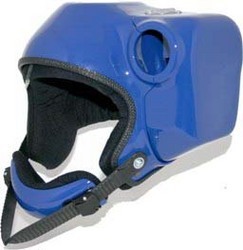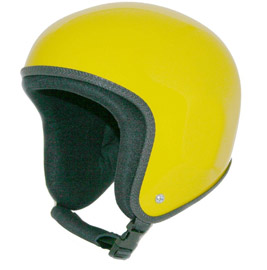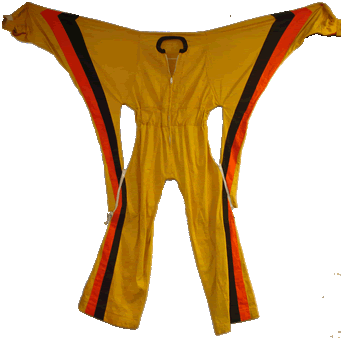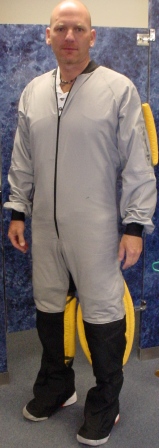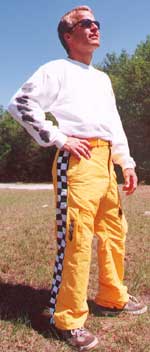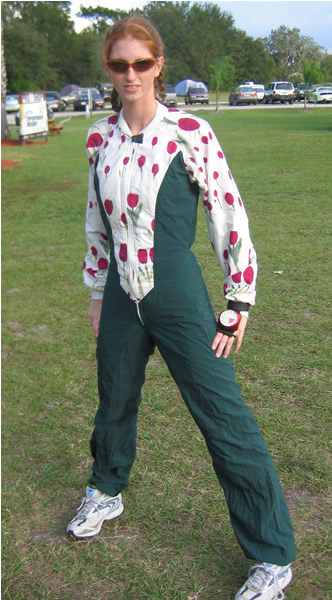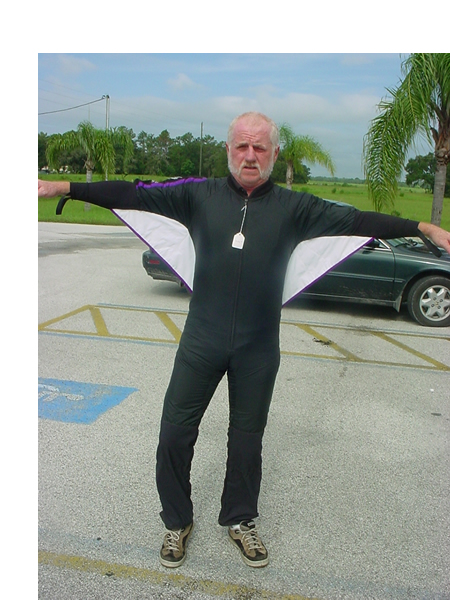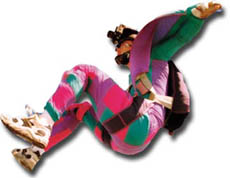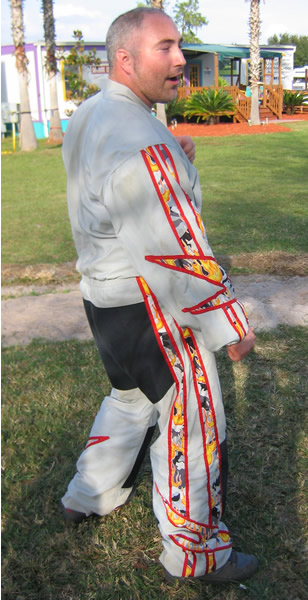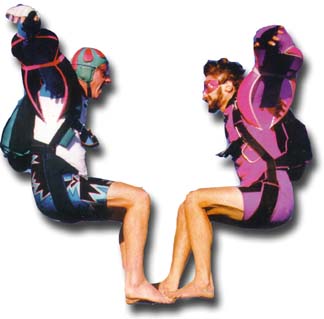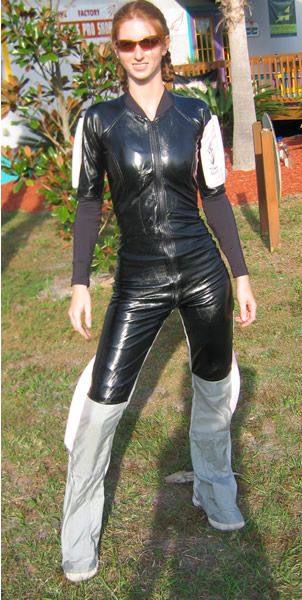-
Content
-14 -
Joined
-
Last visited
-
Days Won
1 -
Feedback
0%
Content Type
Profiles
Forums
Calendar
Dropzones
Gear
Articles
Fatalities
Stolen
Indoor
Help
Downloads
Gallery
Blogs
Store
Videos
Classifieds
Everything posted by admin
-
Sixteen skydivers jumped into the world record books on Friday 31st May 2002 when they all skydived from one of the UK's largest hot air balloons, 10,500ft above Peterborough Parachute centre nr Sibson. The Cameron A300 hot air balloon was flown by 28 year old commercial balloon pilot David Fish who flies full time for Flying Pictures the countries leading commercial balloon operator. With two twin squirrel helicopters circling the balloon, filming the record attempt for national television, it climbed at between 500 & 800 feet per minute to the target altitude of 10,500 feet. After flying for twenty minutes the balloon was directly overhead Sibson airfield. With the skydivers all standing around the edge of the basket and a rapid decent established all sixteen skydivers exited simultaneously. With the loss of just over 1 tonne in weight the balloon entered a very fast climb, causing distortion and partial collapse of the envelope. Eventually levelling off at just over 11,000 ft. "It was quite a wild ride," explains David Fish, balloon pilot and project co-ordinator. "Pretty much as soon as they all left the balloon began distorting and spinning as it climbed rapidly and all I could do was hold on and wait for it to slow down." Velvet Toilet Tissue, whose hot air balloon was used for the record attempt, built a special softer than ever landing zone for the parachutists. The zone, a 10-metre radius circle covering more than 314 square metres, was made from more than 5000 rolls of softer than ever Quilted Velvet loo rolls. The zone could be seen from more than 10,000 feet and acted as a target for the skydivers. All sixteen made the landing zone, with some making good use of the toilet rolls to soften their landing! Team Members Skydivers: 1. Matt Lee 2. Ian Ashpole 3. Andy Bennett 4. Simon Ward 5. Giles Fabrisv 6. David Sawyer 7. Dorian Harwood 8. Martin Williams 9. Steve Springys 10. Stuart Meacock 11. Rose Leggett 12. Mark Harris 13. Chris Donaldson 14. Andy Guest 15. Dave du Plessis 16. Rhino Pilot: David Fish For further information please contact David Fish @ Flying Pictures Ltd. [email protected] Photos: DSCF Flying Pictures Ltd and Simon Ward
-
For about 20 years, Cathie Schlatter has been parachuting at Frankfort’s airport. She has six more days. Skydive Indiana decided to pack up its parachutes and leave the Frankfort airport at Thursday night’s Frankfort Airport Authority meeting. Dave Geyer, president of Skydive Indiana, presented the authority a contract to sell his hangar for $90,000, and the authority accepted, said Mike Reeder, president of the airport authority. Geyer has been in Frankfort for nine years and was in the fourth year of a 20-year lease with an option for five additional years. “They made us an offer to buy the building and cease operations, and we accepted,” Reeder said. Schlatter said Frankfort’s days of having sky divers are over. “Nobody wants to come here,” she said. “Frankfort’s airport has a reputation for being hostile, not just in the jumping community, but in the entire aviation community. (Geyer) was forced to close up shop. It’s sad for me because it used to be so different. Frankfort’s airport used to be a really fun place to go.” Now Schlatter and other Skydive customers will search for another landing zone, she said. “When a restaurant closes up, you go down the street and look for another one,” she sad. “For us, it’s a little harder. But lots of communities love us.” Skydive Indiana will stop jumping at the airport within the next week and will vacate the premises within 30 days, according to the resolution signed by the authority. Skydive Indiana has battled both the authority and Frankfort Flight Services, who runs the day-to-day operations of the airport, for the past two years. In April 2001, Frankfort Flight Services demanded Skydive Indiana stop allowing parachutists to land at the airport because it was dangerous to the parachutists and planes. In response, Skydive Indiana went to court. Three months later, the move landed both sides in federal court. Eventually, both sides agreed to let the jumpers return to the Frankfort airport on weekends until the FAA decided whether they are safe. Skydive Indiana also agreed to dismiss its lawsuit against the authority and the city. Last month, Geyer complained that the reduced hours hampered his business and that his jumpers suffered harassment from the airport’s management. In 1999, Skydive Indiana customers performed 6,000 jumps; in 2000, they did 5,800 and in 2001 they did 3,300, Geyer said. Even though Skydive Indiana will not be jumping at the airport, the FAA will still make a ruling, Reeder said. “(The FAA) won’t just drop this,” he said. “I don’t know when, but they will make a ruling.” The authority is not sure what it will do with the hangar, Reeder said. “We might work with the city engineer and fire chief to see if we can rent it for aircrafts,” he said. “It could act as storage, although other options are available.” Skydive Indiana and Frankfort Flight Service first clashed in July 2000, when both wanted to manage the airport. The authority was unable to decide, with former authority members Stan Smith and Bill Clinton in favor of Geyer’s group and Reeder and Gene Watchbaugh in favor of Frankfort Flight Services. The authority turned the decision over to the Frankfort City Council, and Frankfort Flight Services was awarded the contract. In the following year, both Smith and Clinton were not reappointed to the authority by Mayor Roy Scott. Geyer could not be reached this morning for comment.
-
The enclosed video camera housing has been fully moulded into the shell in a revolutionary new design, making this the narrowest and the safest camera helmet on the market. It also includes the option of using a stills camera. The FFX brings new meaning to the word aerodynamic. The FFX has been designed to provide you with the option of using a stills camera in addition to a built-in video camera. All camera angles have been lined up 'true to line of sight' so there is little compromise to body position or angle. The exterior of FFX helmets is smooth, so there is little worry of line snags thus dramatically reducing the need to cut the helmet away. The FFX features enclosed dual altimeter ports that will fit all makes of audibles.
-
The FF2 has been designed to provide you with the option of using a stills camera in addition to a video camera. All camera angles have been lined up 'true to line of sight', so there is little compromise to body position or angle. The exterior of FF2 is smooth, so there is little worry of line snags thus dramatically reducing the need to cut the helmet away. In addition, all angles on the FF2 have been ergonomically designed to make them aerodynamic and quieter at high speeds. The built in video camera housing has been moulded into the shell and not bolted onto the exterior of the camera, making this the narrowest helmet on the market.
-
-
On a chilly but otherwise beautiful May day, we lost a brother to a freefall collision and subsequent no-pull. John Faulkner (known to many as "Johnny Velocity" or "Johnny Wood"), an avid jumper and tandem instructor with over 1,000 jumps, died on Saturday, May 18 at Skydive Chicago during a two-way freefly jump with Jeff Brown. John, an experienced freeflyer, had been doing tandems for most of the day, and this was thought to be his first non-instructional jump of the day. The plan was for the two to go head-down on exit and for Jeff, who has about 35 jumps, to try to maintain stability and proximity with John. "We got a lot of vertical separation early in the dive (I was low)," said Jeff. "We'd agreed that if I didn't get a good head down, I'd sitfly. I saw him orbit me once while I tried to get into a good head down, and then I decided to go into a sit. "I believe that he tried to catch up with me (from above) after that, and I think I had gotten into a sit when something hit me from behind and on my right side. My right arm went numb and my knee hurt, and I didn't know at first what it was. As I pulled I saw him falling away from me on his back with his arms over his chest. I believe he was knocked unconscious when it happened." John was wearing an open-face hard helmet, had an audible altimeter, and his rig had a Cypres automatic activation device that either was turned off, had cycled off, or malfunctioned, as it did not fire. SSK Industries will test the unit to determine which was the case. Blue skies, Johnny--you'll be missed. Note: This information is from a witness report. The results of the investigation will be released in Parachutist at a later date. Team Funnel (a loose organization of skydivers at Skydive Chicago dedicated to the belief that no one should have to jump alone) sponsored a fundraiser in the names of Johnny and other skydivers who have passed away (for the Make-A-Wish Foundation) on Saturday, May 25 and Sunday, May 26. Their goal was $4,600--the average cost of this foundation's fulfilling someone's wish--and the total raised was over $5,400.
-
Two people fell to their deaths after a freak mid-air collision when a skydiver smashed through the wing of a glider. The glider's pilot also died in the collision at around 2,000ft, which happened at Hinton Airfield, near Brackley, Northants, at about 1500 BST on Saturday. The wing of the glider was knocked off by the force of the impact and both people were killed instantly, a spokesman for the Air Accidents Investigations Branch said. A Northamptonshire police spokesman said the glider came down in a field close to the private airfield. Investigation launched Among the first to arrive at the scene was a crew from Two Shires Ambulance Service who confirmed the deaths. A spokesman said: "We arrived to find a parachutist was deceased and the glider pilot also deceased. "There were no other casualties." An AAIB spokesman said few details of the accident were available but confirmed the tragedy. "A parachutist flew into the glider knocking off its wing," he said. "There are two fatalities ... the pilot and the parachutist." Investigators are due to attend the scene to establish in greater detail how the accident happened - they will be assisted by the Parachute Association.Staff at Hinton Skydiving Centre, which is based at the airfield, were unable to comment as the incident is being investigated. ~ BBC
-
BITHLO -- Carrying parachutes, the three men hopped the fence surrounding the television tower in rural east Orange County early Thursday and rode the elevator 1,682 feet to the top. Then, simultaneously, they jumped from the steel girders to the fog-shrouded cow pasture below. At six seconds, the first chute opened. The second chute opened two seconds later. But Timothy Lee Werling II, who friends told police was addicted to danger, waited a fatal 11 seconds before pulling the cord and plunged to his death at 172 feet per second. As Werling, 30, fell, the video camera strapped to his helmet recorded his final jump. "If he had even pulled it at 10 seconds, he probably would have survived," Orange County Sheriff's Detective Rick Lallement said. Two other men took part in the pre-dawn adventure -- one jumping from a lower platform 1,000 feet from the ground and the other deciding at the last moment not to jump. Werling, who moved to DeLand recently from Ohio, was known as "Sky Punk" for his daring exploits. He had made 600 jumps off towers, cliffs and bridges as part of the extreme sport known as BASE jumping. "When you have a son that lives for the adrenaline of BASE jumping, you sort of expect it," Timothy Werling, 57, said in a telephone interview Thursday from his home in the Cincinnati suburb of West Chester, shortly after learning of his son's death. ". . . He died doing the thing he loved." The cluster of television masts near Bithlo has become popular with BASE jumpers -- an acronym for buildings, antennae, spans and earth. Mountain Dew even filmed a television commercial for the soft drink, showing jumpers leaping from one of the towers. Werling's friends told Lallement that he was the kind of jumper who pushed his jumps to the limit. "They're cocky," Lallement said. "They're big-time thrill seekers. Jumping out of an airplane isn't enough." One of the group called 911 shortly after 7 a.m. to report Werling's death. Werling apparently died an hour earlier. "He's dead," the caller told the emergency operator. "Impact injuries. High speed to the ground." Police said that Werling's friends, whom they did not identify, went some distance to a pay phone at a convenience store to make the call reporting his death. By all accounts, Werling was an experienced sky diver and BASE jumper. Investigators at the scene found a picture of Werling at the New River Gorge in West Virginia. That spot is so popular it is closed annually so jumpers can use it exclusively. Passion for jumping Werling apparently moved to Central Florida to indulge in his passion for jumping year-round. He lived in a one-bedroom apartment in north DeLand, where his landlady remembered him as a "well-spirited" person. He worked as an administrative assistant at Skydive DeLand, a popular sky-diving operation. "I'm very sad," said Mike Johnston, Skydive DeLand's general manager. "He was pretty exuberant and passionate about life." To veteran parachutists, BASE jumping is a perilous version of their sport but draws many seasoned sky divers because of its daredevil stunts and increased rush from jumping at lower altitudes. "It's popular. I've never made a BASE jump," said Brian Erler, a sky-diving cameraman who works at Skydive Space Center in Titusville. "Depending on the altitude, it's total acceleration. I'm sure it's pretty intense." Unlike skydiving, where parachutes open at 2,500 feet after sky divers jump from airplanes at 15,000 feet, BASE jumpers leap from lower heights and have far less time to open their parachutes. Seconds to spare A few seconds is all BASE jumpers have, but skydivers can have more than a minute before pulling open their parachutes. Unofficial counts put the number of BASE-jumping deaths worldwide at 40. There are an estimated 10,000 active BASE jumpers. Because the sport sometimes requires its participants to trespass on private property, jumpers often avoid authorities. "This is a big organization that does this stuff," sheriff's spokesman Carlos Torres said. "It's a common sport. But in Orange County, this is the first documented [BASE-jumping death] we have had." That is not to say jumpers have been avoiding the area. Lallement said the Sheriff's Office had spotted at least eight jumpers in the area on three separate occasions during the past few months. John Stargel, vice president and general counsel for Tampa-based Richland Towers Inc., the parent company for the tower, said the company will review its policies in the wake of the incident. "The tower is fenced. We have security in place," Stargel said. "But if someone is intent on breaching our security, there's only so much you can do to keep somebody from putting themselves in harm's way." Lallement had little tolerance for the BASE jumpers who trespass to get to their jump-off points. In this case, the jumpers violated federal law because the location is regulated by the Federal Communications Commission. ~ Orlando Sentinel
-
Experienced skydiver Tony Weber, died Memorial Day weekend from injuries sustained from a hard landing at Cedartown Georgia, Atlanta Skydiving Center. During a holiday road trip with friends, to celebrate college graduation, Tony made a hard landing under a relatively new Vengence 150, at the DZ. He was airlifted off the DZ and died of his injuries 4 hours later. Tony was a regular jumper at SEMO Skydiving. He was the president of the SIU Skydiving Club. He was a great role model for the new jumpers, and a positive influence on skydiving in general. He was working on his instructional rating and would have been an asset to our club, or any skydiving operation. He was a really good guy. His parents moniter the NG if you would like to make a positive comment. I have the address of his parents if anyone would like to send a card. We are all saddened by his loss, and will miss him. He died doing what he loved best...skydiving. Paul Gholson SEMO Skydiving D-17101 instructor
-
SUFFOLK, Va. May 11 — A former Navy SEAL and skydiving instructor died after he hit his head on a plane during a jump and fell to the ground without his parachute deployed. Brad Foster, 42, of Virginia Beach, was one of 14 parachutists practicing for a show this weekend when he jumped from the plane Friday, officials said. Foster, who had more than 4,000 jumps to his credit, likely died upon impact with the plane, fire Capt. James Judkins Jr. said. Foster's body was found in the back yard of a house about a quarter-mile from Suffolk Municipal Airport, where the flight originated.
-
Gloucester, UK - DENISE Peacock was enjoying what seemed to be a perfect day out in the sunshine with her family - but seconds later a freak accident left her lucky to be alive. The 36-year-old, from Coney Hill, was at a bumper May Day celebration in Gloucester watching a parachuting display when she heard a noise above her head. Before the mother-of-two knew what was happening, she lay writhing in agony on the ground after one of the parachutists lost control in heavy winds, sailed out of the arena, and careered straight into her and her young family. Today the Church Way resident is on crutches and off work - but she knows she's lucky not to have been more seriously hurt. The vending machine operator suffered tissue damage and severe bruising to her legs, while husband Lawrence, 37, and children Amy, 12, and Sean, eight, all sustained cuts and bruises. The parachutist is believed to have broken his leg, and remains in Gloucestershire Royal Hospital today. Ambulances rushed Denise and the parachutist, from the volunteer Falling Rocks parachute team, to the hospital. She was released after eight hours of treatment. He will remain in hospital for at least another week. The family were at Coney Hill Neighbourhood Project's May Day celebrations at Coney Hill Primary School on Bank Holiday Monday when the accident happened. The three-strong volunteer parachute team's performance, which took place at 2.15pm, was meant to be the highlight of the bumper event. "The winds were so strong we thought they wouldn't jump," said Denise. "They took off about 20 minutes late, and they were all over the place. "I don't have a clue how it happened, it was all so fast. "People said the parachutist shouted for me to watch out, but I didn't hear anything. "All I remember is lying on the ground in agony after he smashed into me, hitting the back of my legs. "I was rushed to hospital. I've got a huge lump on one of my legs and I'm told I sustained tissue damage in the other, so I'm stuck on crutches and I can't go to work. "The parachutist is in hospital at the moment - he's badly hurt. It was a nightmare." Parachutist Colin Laker, who landed safely just before his out-of-control colleague, denied the winds were too strong to take the jump - but he admitted he probably got caught in an unexpected gust. "It just happens once in a blue moon. We have to put it down to a tragic accident, I'm afraid," he said."The wind was most definitely not too strong to take the jump. It was very comfortable for us and there was no question of us not doing it. "I understand the parachutist concerned landed beside the woman, and rolled over onto her - it was his momentum that caught her. "He must have been caught in a gust of wind when he was up there, and was knocked out of control. I can only apologise and put it down to a freak accident." Mr Laker said the parachutist did not wish to be identified. Denise claimed she never received an apology from anyone at Coney Hill Neighbourhood Project, who organised the event. But project spokeswoman Val O'Connor claimed it was not their responsibility. "We contracted the Falling Rocks team to do a piece of work for us - and the decision to do the jump was taken by them and them only," she said.
-
ELLINGTON -- As she hurtled toward the ground, the skydiver couldn't open her parachute. Her instructor, Robert J. Bonadies, dove toward her and pulled her cord. But some say it was too late for him to help himself. Bonadies died Monday in the skydiving accident. The student and another instructor who jumped at the same time were not injured. "Most people would say he was a hero," Don Semon, a safety and training adviser for the United States Parachute Association, said Tuesday. Bonadies' death was ruled an accident Tuesday after an autopsy at the chief medical examiner's office. State police and the Federal Aviation Administration are investigating. Family members and friends gathered at Bonadies home Tuesday, sharing memories and calling him a hero. "His smile was contagious," said friend Bill Beaudreau. "He just made you feel good just being around him. I could just see him right to the end, putting his life aside to make sure this person lived, and that's what he did." An electrician, Bonadies, 47, was also a father and grandfather. He had what one relative called "an infectious smile." When it came to skydiving, he was as experienced as they come. He was president of Connecticut Parachutists Inc., a club based at Ellington Airport - about 6 miles from his Vernon house. He had been skydiving for more than 20 years. He completed 2,040 free-fall jumps - 254 in the past 10 months. He also was a long-distance runner. He ran up Mount Washington and trained participants for charity events. "He was a pretty active guy," said his brother-in-law, Mark Miller. "He loved his family. He loved his work. He loved to skydive." That much is evident in a photograph of Bonadies skydiving. In it, he is smiling as he sails through the bright blue sky with a student harnessed beneath him. Bonadies' relatives and friends at Connecticut Parachutists said he saved the student's life Monday. Semon, who also is a member of the club, said Bonadies and another instructor were on either side of the student when they jumped at 12,000 feet from a Cessna 182. When he saw that the student couldn't pull the handle to open her parachute, he did it for her, Semon said. Mark Miller said Bonadies dove through the air to catch up with her. "He maneuvered himself under her. He pulled her cord so her chute opened. He pulled his reserve chute. But he was too close to the ground," Miller said. Semon, however, said Bonadies never got a chance to attempt to open either his main or reserve parachute. The police said when they found him, the reserve chute was open, but both police and Semon said it could have been forced out by the impact. Meanwhile, television station WTIC reported Tuesday that Bonadies was not wearing a device that would have automatically opened his chute at about 1,000 feet. Although many skydivers choose to wear the so-called automatic activation device, Bonadies did not, WTIC reported. All novice skydivers who are jumping with the Connecticut Parachutists group are required to wear the devices. From the USPA Safety & Training Newsletter Vol. 2, Issue 6 Instructor ResponsibilitiesRecently during a Category C student skydive, an AFF Instructor was killed after the formation funneled at the student's pull altitude. The two instructors and their student tumbled, and eventually one of the instructors released and deployed his main parachute at a low altitude. The other instructor continued tumbling with the student and deployed the student's main parachute just as the AAD deployed the reserve. The instructor reached the ground before he could deploy his own parachute. The student landed her bi-planed main and reserve without further incident. In situations such as this, altitude awareness is critical. Things happen very fast due to the increase in fall rate while tumbling, which only serves to add to the problems the instructor is already dealing with while trying to get the student deployed. With this tragedy, Instructors are reminded of the protocol that has been established regarding students and pull altitudes. The AFF Syllabus of the Instructional Rating Manual lists the following guidelines regarding deployment problems: 5. General:a. The instructors must assure student main deployment by 3,500 feet to allow both instructors time to get clear and open by 2,000 feet. b. No instructor should ever get above a student. Note: AADs often activate higher than the preset altitude. c. The instructor(s) must ensure reserve deployment by 2,500 feet to get clear and open by 2,000 feet. d. Under no circumstances should an instructor attempt to catch a student or remain with a student below the instructor's minimum deployment (2,000 feet). e. The instructors must take care that one does not deploy the student's main while the other deploys the reserve. (1) Only if the main deployment handle is inaccessible should the reserve-side instructor deploy the student's reserve parachute. (2) Many systems have reserve-side instructor deployment handles to make deploying the main parachute easier for the reserve-side instructor. USPA strongly encourages all skydivers, especially instructors, to use an AAD, which may have changed the outcome of this event. An audible altimeter can also serve to provide an additional altitude warning for instructors while working with students. Solo students, and instructors and students who are using tandem equipment must wear an AAD.
-
The regular TONY SUIT is made entirely of Polycotton. It comes with upper and lower arm grips, and our famous curly leg grip. Each suit is adjusted to meet the individual skydiver's measurements and needs. The TONY SUIT is tailored for the heavier jumper. We also offer an all acrylic TONY SUIT called the HI-LIFT SUIT. Acrylic, which is a heavier fabric than polycotton, allows us to make the suit smaller without losing the drag. The original suit that tony started making all those years ago but still one of the best. Better suited to jumpers needing to slow down their fall rate.
-
The SWOOP SUIT is our all around model. The body length comes fairly snug, and has a piece of spandex down the middle of the back to allow a snug torso length while still allowing you to touch your toes. There is enough room for extra clothes in the winter. The arms can be made of spandex, cot'en felt or polycotton. The legs are made of cot'en felt or polycotton. They are loose and will be adjusted to fit the jumpers height, weight and fall rate requirements. The front can be made in nylon, cot'en felt, or polycotton. Nylon front gives the fastest fall rate, then the cot'en felt, and the polycotton gives the slowest fall rate of the three.
-
These pants were modeled after the "Spacesuit" legs and are available in 4-ply, polycotton, and in suplex. These pants are also used with the C-Wing jacket for filming Tandems then upon landing one might change tops to jumpmaster AFF or its now possible to buy a top that has padded shoulders to jumpmaster a tandem see "Multi suit".
-
The Space suit is our latest freefly suit. Designed around the A.D. challenge in Olav Zipser's space games. Where a standard freefly suit tends to make one float during a transition, a smaller lighter suit does not. Its a very nice suit to fly as there is less drag and flapping. If you need lift because you are possibly a bit heavier, this suit might not have enough drag for you, unless of course your partner of equal height and weight is also wearing one. The suit comes with stripes as an option. The fit is a little more snug than our freefly and tie-fly suits. Standard fabric for the SPACE SUIT is 4 ply. A fabric heavier than suplex, but ligther than poly cotton.
-
We offer the CAMERA SUIT with four different types of wings. It is very important that the correct wing type is chosen. TYPE A is a FASTEN WING for pull-out, ripcord, or bottom of container throw-away. TYPE B is a WINGLET for leg strap or belly band throw-away and meets the suit above the lateral band of your rig. The "C"-wing is for flat flying and sit flying. It goes up on the arm like a sit wing and down to the leg strap like an "A" wing. If you want a sit wing on the back of the arm refer to the SIT SPECIAL order form. The front can be either nylon, cot'en felt, or polycotton. The sides can be cot'en felt or polycotton. The front of the wings are made of nylon for lift and the back can be either cot'en felt or polycotton.
-
The Multi-Suit is a two piece jacket and pants arrangement. It's possible to get one or two pair of pants (Freefly or 4-way), and 5 different jackets. Each jacket is designed around 4-Ways, Big Ways, Camera wings, Sit Fly or Head Down. D.Z. professionals enjoy this suit as they typically have to land and run to the plane changing jackets as they go. Free fly schools can also use just the legs for early head down then just the arms for early sit flying then incorporate the two as the student learns the freeflying positions.
-
The main difference between these two freefly suits is that "The Freefly Suit" is typically a multi paneled suit of different colors and fabrics usually polycotton and is suited to the mid weight skydiver. "The Tiefly" suit is a lightweight "cotn' felt" body with usually a cotton arm and leg. this heavy cotton has good drag characteristics with a heavier (Harley-Davidson) type of beat about it and lends its self to tie-die and marbling perfectly. It also comes in many solid colors such as navy, royal, black, white, green, gold, orange, and red. This arrangement of a light body with heavy cotton limbs is our most comfortable slow falling suit, on hot days particularly.
-
This suit has dual wings on each arm. Making sit flying very easy. It's the best suit for sit flying if you want to do tight sequential on your skydive. If you are not to light it's great to have cot'en felt legs on this suit for head down or free flying. The only problem is that the fall rate speeds up when you go head down in a SIT SUIT. It's a great suit for free style and board surfing too. A smaller wing is recommended for these two events. Camera people are using the SIT SUIT with baggie legs for all types of camera work.
-
The PIT SPECIAL comes in either a nylon, cot'en felt, or polycotton front. Spandex covers the back and hips. This gives a tighter, no flap fit but still allows a full range of movement. Over the years we have removed the spandex from the grip area on the male pit. This gives a better feel during a block move when cranking is involved and also makes the suit last longer. The entire legs are made of cot'en felt or polycotton. We offer spandex, cot'en felt, or polycotton forearms. Although this is the suit the worlds top team are using, it can still be used for fun jumping if the jumper is average, or lighter than average weight. We suggest spandex forearms for the light weight fun jumpers and for teams ( We also make cot'en felt or polycotton slip-ons to wear on the forearms for larger loads). For the medium weight jumper who prefers a skin tight fit over the loose SWOOP SUIT, regular cot'en felt or polycotton forearms are recommended.
-
-
This suit is for the skydiver who enjoys the art of sit flying, has a twin wing on either arm, which are made from F111, also has spandex at the lower part of the front, and spandex panels which runs up the centre and across the back. Available in long or short leg. Can also be made in just a jacket form.
-
A suit which has spandex panels incorporated into the front and upper arms, and has a swoop cord running through the suit from one hand to the other, so as when the arms are stretched out, it pulls on the spandex panels to give you a temporary wing. Still comes with either nylon or polycotton front, forearms can also be either spandex or polycotton, legs are made from polycotton. Can be ordered with or without boosters.
-
A suit for the skydiver who enjoys freefall photography. Can be made in either the Micro or Macro style. Has a wing sewn into the side seam of the jumpsuit, and runs from the wrist to the mid waist, the wing can be made out of either nylon or polycotton This type of suit is also available in a jacket only form. Can be ordered with or without boosters.



